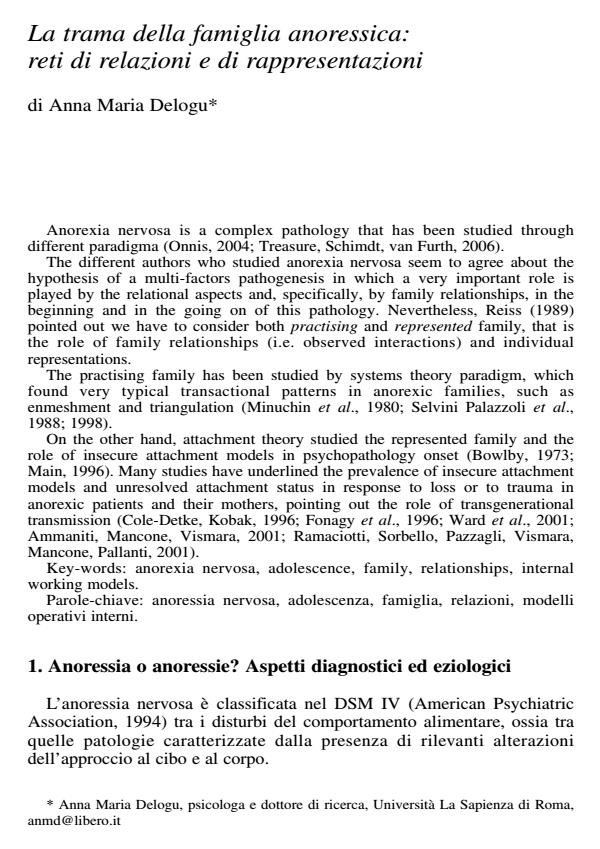La trama della famiglia anoressica: reti di relazioni e di rappresentazioni
Titolo Rivista SALUTE E SOCIETÀ
Autori/Curatori Anna Maria Delogu
Anno di pubblicazione 2009 Fascicolo 2009/3
Lingua Italiano Numero pagine 18 P. 94-111 Dimensione file 156 KB
DOI 10.3280/SES2009-003006
Il DOI è il codice a barre della proprietà intellettuale: per saperne di più
clicca qui
Qui sotto puoi vedere in anteprima la prima pagina di questo articolo.
Se questo articolo ti interessa, lo puoi acquistare (e scaricare in formato pdf) seguendo le facili indicazioni per acquistare il download credit. Acquista Download Credits per scaricare questo Articolo in formato PDF

FrancoAngeli è membro della Publishers International Linking Association, Inc (PILA)associazione indipendente e non profit per facilitare (attraverso i servizi tecnologici implementati da CrossRef.org) l’accesso degli studiosi ai contenuti digitali nelle pubblicazioni professionali e scientifiche
La trama della famiglia anoressica: reti di relazioni e di rappresentazioni - Anorexia nervosa is a complex pathology that has been studied through different paradigma (Onnis, 2004; Treasure, Schimdt, van Furth, 2006). The different authors who studied anorexia nervosa seem to agree about the hypothesis of a multi-factors pathogenesis in which a very important role is played by the relational aspects and, specifically, by family relationships, in the beginning and in the going on of this pathology. Nevertheless, Reiss (1989) pointed out we have to consider both practising and represented family, that is the role of family relationships (i.e. observed interactions) and individual representations. The practising family has been studied by systems theory paradigm, which found very typical transactional patterns in anorexic families, such as enmeshment and triangulation (Minuchin et al., 1980; Selvini Palazzoli et al., 1988; 1998). On the other hand, attachment theory studied the represented family and the role of insecure attachment models in psychopathology onset (Bowlby, 1973; Main, 1996). Many studies have underlined the prevalence of insecure attachment models and unresolved attachment status in response to loss or to trauma in anorexic patients and their mothers, pointing out the role of transgenerational transmission (Cole-Detke, Kobak, 1996; Fonagy et al., 1996; Ward et al., 2001; Ammaniti, Mancone, Vismara, 2001; Ramaciotti, Sorbello, Pazzagli, Vismara, Mancone, Pallanti, 2001).
Key-words: anorexia nervosa, adolescence, family, relationships, internal working models.
Parole-chiave: anoressia nervosa, adolescenza, famiglia, relazioni, modelli operativi interni.
Anna Maria Delogu, La trama della famiglia anoressica: reti di relazioni e di rappresentazioni in "SALUTE E SOCIETÀ" 3/2009, pp 94-111, DOI: 10.3280/SES2009-003006